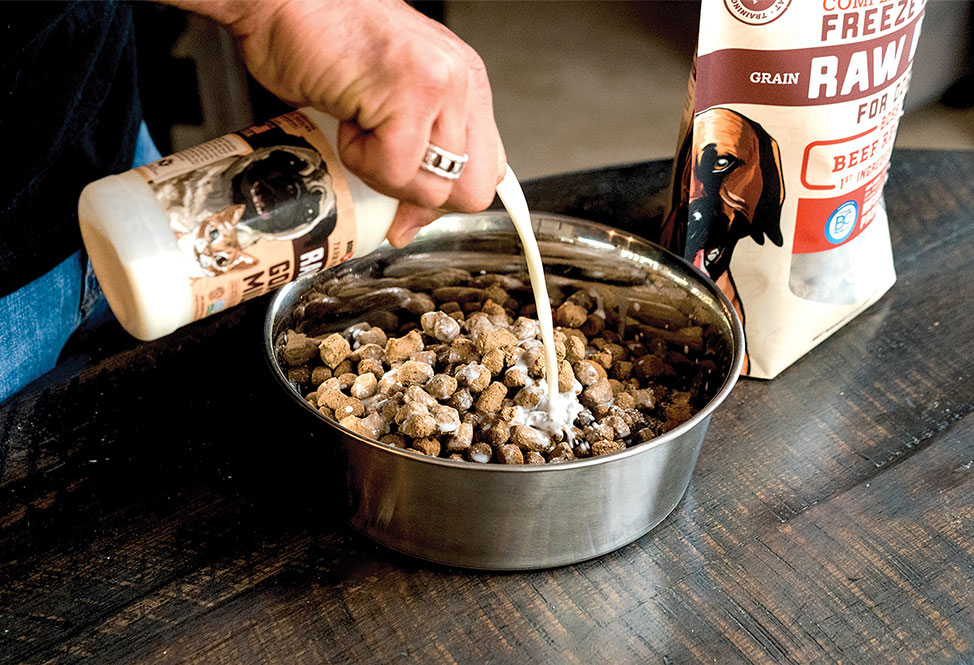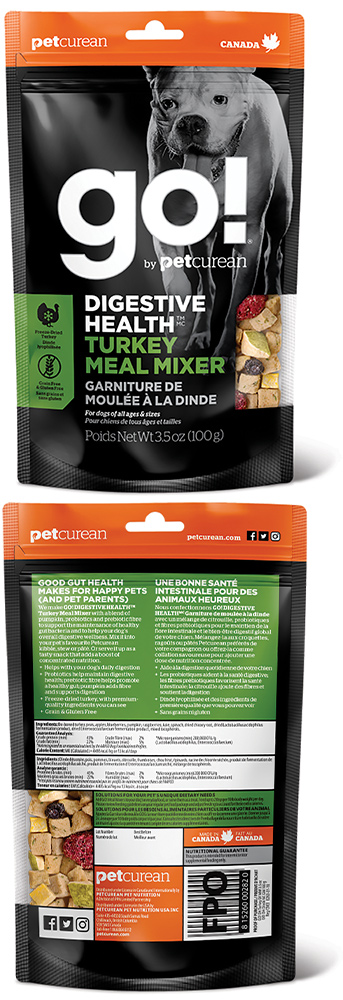This article was published in the December 2019 issue of Pet Food Processing. Read it and other articles from this issue in our December digital edition.
The fact is, humans and animals are physiologically different. While pet parents tend to transfer their own nutritional concerns onto their pets, albeit out of love, they rely on pet food manufacturers to base formulations on proven nutritional science. “A successful pet food formulator carefully considers the science behind a trend, the size of the trended product and the diversification of the product portfolio,” says Patrick Luchsinger, manager of marketing and business development, pet food segment, Ingredion Inc., Westchester, Illinois. “If a supplier cannot provide evidence of benefits about the ingredient, the chance is that there is no — or not enough — evidence or scientific data to support it, thus hyperbole.”
The fact is, pet parents are concerned about what they feed their four-legged companions. A 2017 survey conducted by Nestlé Purina PetCare Company, St. Louis, found that 84% of pet owners are concerned about the ingredients in their pets’ food. More than four out of five pet owners are likely to read the list of ingredients in pet food before buying it. “Many dog and cat owners are often confused about what constitutes safe and healthy food,” says Jason Gagne, veterinary nutritionist with Purina. “They have misperceptions about ingredients and aren’t clear about what types of nutrients their pets need.”
“A successful pet food formulator carefully considers the science behind a trend, the size of the trended product and the diversification of the product portfolio,” says Patrick Luchsinger, Ingredion, Inc.
The fact is, food ingredients may be digested and used differently by animals than humans, which means it is paramount that formulators do not succumb to the latest fad or speak to unsubstantiated trending fears when developing pet foods. “Consumers often read the ingredient panel on a bag and make a judgement about whether the food is good or bad. We need to move away from the focus on ingredients and instead focus on the nutrients those ingredients provide,” says Jennifer Adolphe, Ph.D., nutrition manager, Petcurean, Chilliwack, British Columbia. “We need to educate people to seek out the nutrient profiles of foods and provide education about how to read and interpret the profiles.”
Gagne agrees. “Since pets clearly have different nutritional needs than their owners, pet food scientists have developed complete and balanced meals that give pets all the nutrition they need in one product. We look beyond the latest ingredient fad and develop pet food based on a smart blend of nutrients that supports pets’ overall health,” he says.
This includes differentiating recipes based on the nutritional needs of different breeds, as well as size, age and lifestyle. This is why table food is not a smart option for pets. Yet, some pet parents believe that homemade is fresher and less processed than commercial pet food.
The reality of raw and homemade
Researchers at the University of California-Davis School of Veterinary Medicine examined and evaluated 200 popular homemade dog food recipes in 2013. They found only a few were nutritionally complete and balanced. In fact, 95% of the homemade dog foods were missing necessary levels of at least one essential nutrient. Commercially produced pet food, on the other hand, typically follows the strict standards and safety guidelines set forth by the Association of American Feed Control Officials (AAFCO).
Part of the attraction to homemade is the trend in minimally processed foods. This has been transferred to pets in the form of raw food diets. The belief is that these foods contain more intact nutrients and enzymes, and therefore are better for the body. However, the experts caution that “raw” is complicated. “Unless it is formulated correctly, raw food recipes can lead to nutritional deficiencies and illness,” Gagne says. “The reality is that raw meat for dogs does not always provide the nutrients your dog needs. It can also contain dangerous bacteria that is harmful to both you and your dog.”
Pathogenic bacteria may make pets sick as well as infect pet parents. “Raw pet food providers need to ensure that they have excellent control practices in place, such as sanitation practices, microbiological testing protocols and potential inclusion of ingredients that can control microbial contamination,” says Jim Mann, senior global antioxidant and food safety product manager, Kemin Nutrisurance, Des Moines, Iowa. “By doing this, they can minimize the inherent risks with this type of companion animal diet.”
Basel Nassar, chief executive officer and founder, Boss Dog Brand, Duvall, Washington, believes that raw food diets, however, are not a fad and are not going away. Quality and handling are key to safety and nutrition. The company’s raw goat milk is sourced from free-range goats, raised without antibiotics or added hormones. It is formulated with taurine, an amino acid that helps support healthy circulation, as well as docosahexaenoic acid, an omega-3 fatty acid that helps maintain a healthy skin and shiny coat. The milk is sold frozen, which functions as a natural preservation method.
Offal good
Boss Dog Brand also offers freeze-dried raw nuggets with beef, chicken or white fish/salmon. The nuggets are a complete and balanced formula that delivers protein and other nutrients while being free of grain, soy and corn. The nuggets are enhanced with probiotics for digestive health. All three varieties include offal and ground bone, a meal byproduct of meat processing.
Meal products should not be feared, explains Marcie Campion, vice president of technical services, Pro-Pet LLC, St. Marys, Ohio, a business of Cargill. “Meal products are basically dried, ground, concentrated forms of the meat ingredients from which they are made,” she says. “Chicken meal, for example, is a concentrated source of meat and bone of chickens and is an excellent source of protein and minerals.”
Offal, like other by-products, should not be a source of fear either. Examples of these ingredients include chicken hearts and beef liver. “Offal and other byproducts can also provide a sustainability advantage,” Campion says. “These ingredients may be passed over by humans but are highly nutritious for pets.”
The dish on dairy
Similar to the human food chain, there’s confusion regarding dairy consumption by cats and dogs. Much of this comes from humans who have real or perceived sensitivities or intolerances to lactose, the inherent sugar in milk. When lactose does not get digested, it leads to gas, bloating and gastrointestinal distress. The fact is, dogs and cats love dairy. Unless they cannot digest lactose or have a diagnosed dairy allergy, cheese, ice cream and even milk may be nutrient-dense sources of protein, essential fats, vitamins and minerals.
The Bear & The Rat: Cool Treats for Dogs, Hygiene, Colorado, markets two lines of frozen dairy treats for pets. One based on cow’s milk, the other on goat’s milk. Both lines are formulated with a digestive aid that assists with healthy stools and less gas. “We added the goat’s milk line for pets that are sensitive to cow’s milk,” says Meg Meyer, president and co-founder of the 10-year-old company. “Our products are all at least 75% moisture, so they provide hydration, which is crucial to many pet’s diets.”
Alternative proteins
Plant-based, vegetarian and vegan is all the buzz in the human world, so of course this trend is transferring to pet food. Alternative sources to animal protein include proteins from plants, fungi, insects and cell-based lab production. “A common misconception is that dogs need animal meat in their diet, but what they truly need is protein. And protein is readily available to dogs from a variety of plant and fungi-based sources,” says Ernie Ward, chief veterinary scientist, Wild Earth Inc., Berkeley, California, a vegan pet food company. “In fact, many would be surprised to learn that the fungal proteins used by Wild Earth contain more protein per gram than beef.”
Wild Earth uses yeast protein as its main ingredient, which provides all of the essential amino acids that dogs require, according to the company. Other purposeful ingredients — oats, sweet potatoes, chickpeas, blueberries, pumpkin and spinach — provide fibers, vitamins, antioxidants, chloride and potassium.
Legumes are the most common source of plant protein. The challenge is that plants do lack essential amino acids required for adequate nutrition. “Legumes, such as pea protein, are high-quality ingredients that contribute meaningful levels of protein, fiber and micronutrients to dogs’ diets,” Luchsinger says. “Pea protein contains essential amino acids such as leucine, lysine and arginine. However, pea protein should be complemented in pets’ diets with other ingredients, like meat protein, to balance out the amino acid profile.”
“We need to move away from the focus on ingredients and instead focus on the nutrients those ingredients provide,” says Jennifer Adolphe, Ph.D., Petcurean.
Legumes, however, are currently on some pet parent’s list of feared ingredients due to some of their inherent compounds, such as lectins. “Lectins are carbohydrate-binding proteins commonly found in a wide variety of crops and, when high quantities of raw seed or flour are consumed, they can result in undesirable health effects,” Adolphe says. “However, research has shown that moderate heat treatment, such as that used to make kibble and canned pet foods, inactivates the anti-nutritional properties of lectins.”
Legumes are often used in large quantities in grain-free diets, as they contribute some of the functionalities of standard grains. However, as the result of a recent report from the US Food and Drug Administration (FDA) suggesting a potential link between grain-free diets and dilated cardiomyopathy (DCM) in dogs, some consumers have become hesitant to feed grain-free diets. However, there has been no published evidence to support a cause-and-effect relationship between grain-free diets and DCM in dogs. “For many pets, grain-free diets are an excellent option,” Adolphe says. “In some cases, they are the only option, particularly for pets who do better on a diet without grains, including those experiencing adverse food reactions.”
Responsible grain-free brands will ensure that the food is formulated to deliver complete and balanced nutrition. The fact remains, however, that staple grains such as corn, rice and wheat are responsible for providing quality energy that pets require. “The current trend toward grain-free pet foods has led consumers to believe that corn, rice and their ingredient derivatives are fillers when, in fact, ingredients like corn gluten meal are highly digestible and good for pet health,” says Yvonne Wang, animal food scientist at Wild Earth.
Gagne explains other benefits grains offer. “When it comes to the nutrients pets need, grains deliver. Grains provide antioxidants, energy-rich carbohydrates and fiber to promote digestion. In fact, grains, especially corn, are key for helping pets to digest the other nutrients in their food. Grains in dog food can also support healthy skin and hair, plus support healthy immune systems and more,” he says.
The importance of additives
Food safety has always been a priority in pet food manufacturing. The fact is that modern distribution networks necessitate the use of preservatives to ensure customers purchase and use products that are of the highest quality after what may be months of storage. Yet, traditional preservatives with their often chemical-sounding names are no longer welcome by many pet parents.
“Consumers want their pets’ food to be fresh and safe, but they prefer that those attributes be delivered through more natural solutions,” says Robert Ames, senior business development manager, meat and pet food, Corbion, Lenexa, Kansas. “Manufacturers can choose proven preservative solutions that use plant-based antioxidants and organic acids like vinegar, which are naturally produced through fermentation, to slow oxidation and inhibit spoilage and pathogens.”
In dry pet foods, where the concern is largely about the loss of shelf life due to lipid oxidation, antioxidant solutions based on natural plant extracts can be highly effective. “The use of natural antioxidants has become commonplace in the pet food industry,” Mann says.
While smell and taste are important, aesthetics have also become an important consideration in pet food manufacturing. Pet parents buy with their eyes. “The movement toward natural flavors, colors and ingredients is no longer limited to the human food and beverage industry,” says Chris Naese, vice president of business development, Florida Food Products, Eustis, Florida. “We’re seeing an uptick in interest in integrating fruit- and vegetable-based ingredients into premium pet nutrition products.”
While fruits and vegetables introduce visual appeal and nutrition, some formats provide functionality, such as stabilization and texture development. They may be able to replace less desirable gums and starches. “We don’t think it’s a fad that consumers want their pet foods and treats free from artificial ingredients, colors and additives, since pet parents hold the same standards for pet food as they do food for themselves,” says Jeannie Swedberg, director of business development, Tree Top Food Ingredients, Selah, Washington. “More pet food manufacturers are taking advantage of the benefits of fruit ingredients.”
Cranberries led the pack for fruit inclusions in pet foods in the past year, followed by blueberries, then apples, according to data from Mintel. “In terms of practical functionality, these fruit ingredients and others like them can add fiber, aid with texture, add color and help control moisture,” Swedberg says. “When included in a pet treat, fruit ingredients add no fat and very few calories, to supply a positive impact on weight management.”
Whether it’s a concern about the processing method, the ingredients included or excluded, or the additives used to prolong shelf-life, the emotions stirred by false information can influence purchase decisions. A study published in the journal Science in March 2018 analyzed the spread of true and false news online and found that false news reached more people than the truth. Brands must continually counter false information with facts to keep what’s truly, nutritionally best for pets in focus.
Read more about product development, ingredients and formulation.



